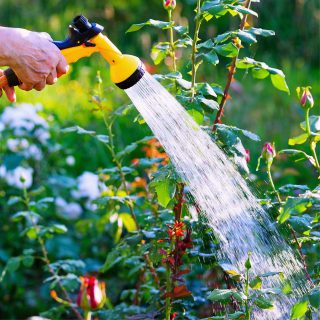 Q: How do I know when to water?
Q: How do I know when to water?
A: There is no magic formula on how often or how much water to apply. It depends on several factors: plant type, temperature, precipitation, wind, sun exposure, soil conditions and root competition. The same exact plant, placed in 2 different conditions within your yard can have widely varying water needs.
For established plants (> 2 years planted), check the upper 3-4” inches of soil in a couple of areas around the plant. If moisture is detected you do not need to water. However, check again in a day or two, especially during hot, sunny or windy weather.
Newer plants (< 2 years planted) should be checked more frequently for moisture in the root ball area. Some plants with dense foliage (like Hydrangeas, Arborvitae and Ornamental Grasses) will shed overhead rainfall and water to the soil outside the root ball. Therefore, the soil next to the plant may appear and feel moist, the root ball where young roots are trying to gather water may be very dry and cause the plant to decline.
Plants placed under or near larger trees, evergreens or shrubs will often need greater quantities and frequency of water to compensate for the aggressive root competition and rainfall interception by the larger plants.
Q: How much water should I apply and how often?
A: On average, a good rule of thumb is to thoroughly water about twice per week. Slightly increase frequency if weather is very sunny, hot or windy. Decrease frequency if there’s been a substantial rainfall (>1/2”), or if weather is cool or cloudy.
When you water, be sure to target the root ball and surrounding soil, not the foliage. Apply the water slow enough so it can soak in, rather than running off to the side.
Deep and less frequent watering is much more effective for building a strong root system. Frequent, light sprays of water encourage the root system to remain shallow, making the plant more likely to suffer drought stress. Soaker Hoses are a great way to deeply water large groupings of plants or hedges.
Q: Do I really need to water, I have a sprinkler system?
A: Most sprinkler systems do a fine job of watering the lawn, but fail to sufficiently water perennials, trees and shrubs. The bottom line is that you should still rely on manually checking and watering your plants as needed in the manner described above.
Q: Can plants be overwatered?
A: Yes, plants can be overwatered. Roots need oxygen to survive, therefore too much water in the soil suffocates the roots and they lose their ability to absorb water. Root rot and other diseases often add to the problem when the soil remains consistently wet. Plants that are overwatered tend to look wilted all of the time, plus they often hold onto their wilted leaves. It can be difficult to realize the waterlogged condition unless you dig down to see what’s going on below the surface.
Q: If my plants look wilted, should I just automatically water them?
A: Always check the root ball and soil first to be sure watering is needed before reaching for the hose. Some plants (especially recently planted) will experience what we call the “3 O’Clock Wilt”. That is, during the hottest part of the day, many leafy plants like Hydrangeas and Japanese Maples can’t move water to the leaves fast enough, resulting in temporary wilting. Often, these plants will perk up and look fine in late evening.
Evergreens do not typically wilt when they start to dry out. Therefore, it is important to check the root ball more frequently for moisture and water as needed.
Q: My new plant is dropping leaves. Is it dying?
A: Plants that have shown signs of wilting and leaf drop can survive and are most likely suffering from transplant shock. Wilting shows there is a need for water, while the leaf drop is the plants’ way of lowering its water needs. In most cases, the plant will continue to develop normally and in fact may generate more leaves if the moisture and weather conditions are right. It’s usually just a temporary setback, so be patient and continue to care for them.
Q: Should I apply mulch?
A: Yes, a 1-2” layer of mulch will help protect the roots from temperature extremes, allow water to soak into the soil better and decrease evaporation from the soil. Plus it can reduce erosion and weed growth…AND it looks great! Remember to keep mulch 3-6” away from the base of the plant to prevent bark or stem damage.
The last few drops of advice:
- Water the soil, not the leaves. As mentioned earlier, newly planted evergreens and leafy shrubs can shed water out past the roots.
- Smaller plants have smaller root balls and dry out faster. Therefore they may need to be watered more often than a larger plant.
- Different plants have different water needs…one watering schedule does not fit all the plants in a given area.
- Keep watering your plants through the end of the season. Depending on weather, that could be October or November.
- Well established annuals should be watered daily – preferably in the morning to get through the hottest part of the day!
